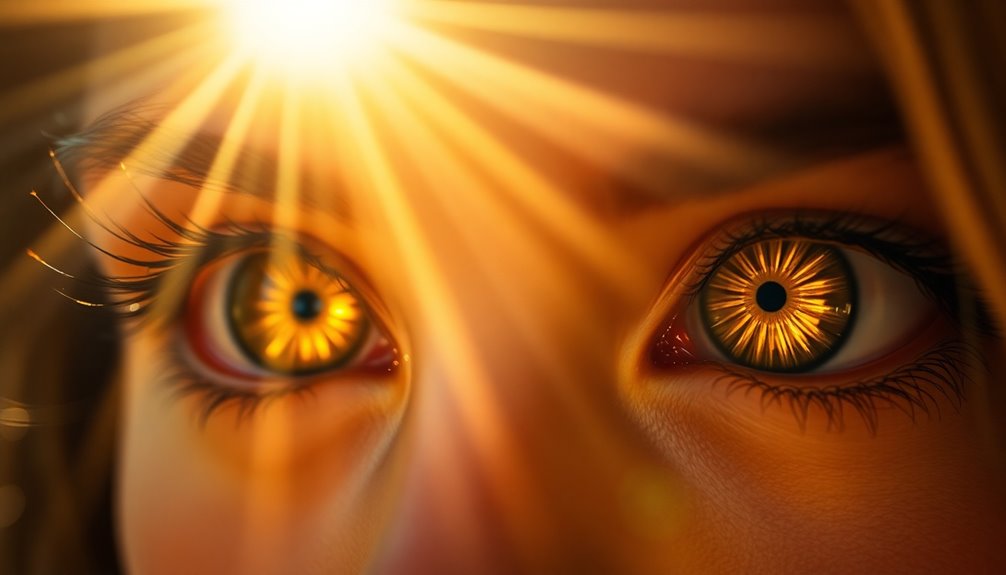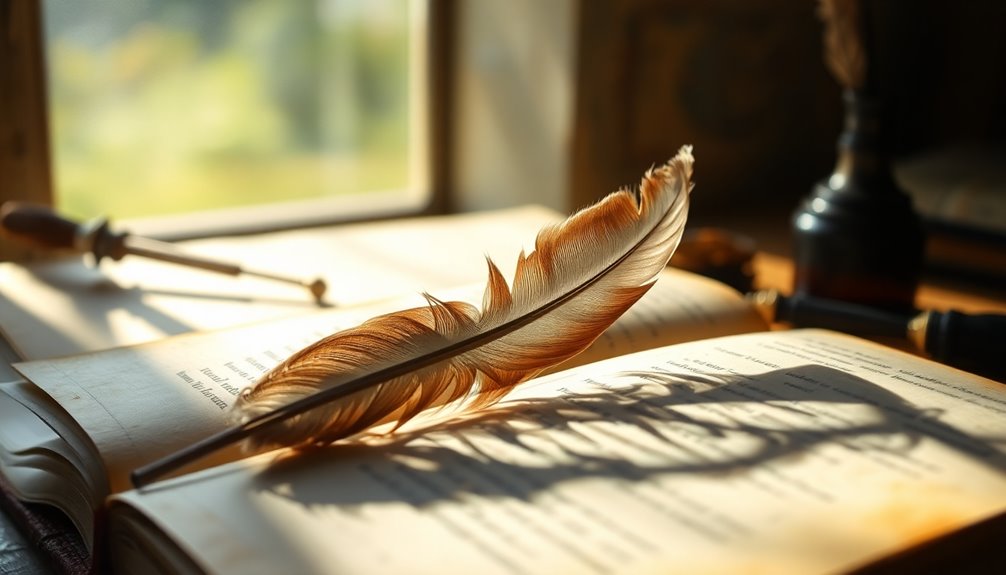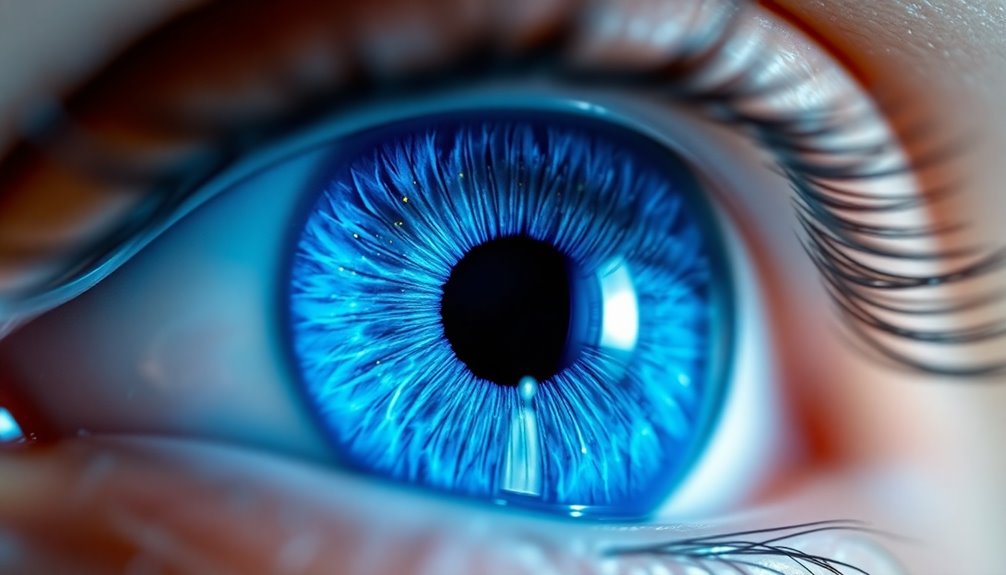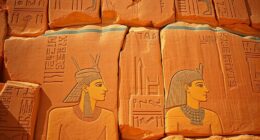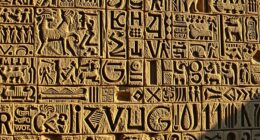Symbolism is a fantastic way to find deeper meanings in colors, objects, and stories! For example, the green light in *The Great Gatsby* stands for unreachable dreams. A red rose often symbolizes love, while the owl can represent wisdom. In many cultures, a dove symbolizes peace. Everyday items, like a wedding ring, show eternal love, and a mirror represents self-reflection. Even historical symbols exist, like the Statue of Liberty, which stands for freedom and hope. Each symbol invites you to explore its meaning! Keep an eye out, and you'll discover even more exciting symbols all around you!
Key Takeaways
- The green light in *The Great Gatsby* symbolizes unattainable dreams and the pursuit of the American Dream.
- The conch shell in *Lord of the Flies* represents civilization, order, and the fragility of societal structures.
- The mockingbird in *To Kill a Mockingbird* symbolizes innocence and the moral imperative to protect the innocent from harm.
- The color red often symbolizes passion and strong emotions, while blue typically represents calmness and tranquility in various contexts.
- Doves are widely recognized as symbols of peace, embodying harmony and tranquility within communities and relationships.
Understanding Symbolism

Symbolism plays an essential role in storytelling, as it uses various objects, colors, and actions to convey deeper themes and ideas. When you read a story, you might notice symbols that represent an idea or feeling. For example, the color red often symbolizes passion or danger. This can make you feel excited or nervous, depending on the context.
In literature, characters interact with symbols in ways that reveal their personalities and motivations. Take the conch shell in *Lord of the Flies*; it symbolizes order and civilization. This helps you understand the story's deeper meaning.
Context is really important when figuring out symbolism. A single symbol can mean different things based on cultural background or the overall narrative. For instance, a rose might symbolize love in one culture, while in another, it can represent secrecy.
The effective use of symbolism enhances emotional engagement, drawing you into the story. It invites you to explore underlying themes and messages, making reading an exciting adventure.
Types of Symbolism

Exploring the various types of symbolism can deepen your understanding of literature and enrich your reading experience. Symbols play a crucial role in storytelling, helping you connect with themes and emotions.
Here are three types of symbolism you'll encounter:
- Conventional Symbols: These are widely recognized meanings. For example, a red light often signals danger, while it can also represent love, allowing for immediate understanding across different audiences.
- Literary Symbols: Unique to specific works or authors, like the green light in *The Great Gatsby*, which symbolizes unattainable dreams and aspirations. Authors use symbolism to convey deeper meanings.
- Cultural Symbols: These reflect the beliefs of particular societies. The dove often symbolizes peace, but its meaning can vary between cultures.
Additionally, there are personal symbols, shaped by individual experiences, and mythological symbols, like the phoenix, representing rebirth.
Each type of symbolism in literature adds layers of meaning, making stories more engaging and memorable. By recognizing these symbols, you'll enhance your appreciation of the universal meanings they convey!
Examples in Literature

Let's explore some of the most exciting symbols found in classic novels!
Each story uses symbols to add deeper meaning and help you connect with the characters and their journeys.
From the green light in *The Great Gatsby* to the conch shell in *Lord of the Flies*, these symbols can really make you think about the themes of dreams, order, and morality.
Notable Literary Symbols
Literary symbols enrich narratives, inviting readers to explore deeper into themes and emotions. These symbols help you connect with the story in unique ways. Here are some notable literary symbols you should know:
- The Green Light in *The Great Gatsby*: This light symbolizes Gatsby's dreams and desires, representing the elusive American Dream and all that he hopes to achieve.
- The Conch Shell in *Lord of the Flies*: The conch shell symbolizes civilization and order. It shows how fragile society can be when chaos takes over.
- The Mockingbird in *To Kill a Mockingbird*: This bird represents innocence and the idea that hurting innocent beings is wrong, reminding us of important moral lessons.
Each of these symbols carries powerful meanings. For instance, in *The Scarlet Letter*, the letter "A" symbolizes sin and societal judgment, constantly reminding the protagonist of her mistakes.
In *The Metamorphosis*, Gregor's transformation into a bug symbolizes alienation in modern society. These examples of symbolism make literature richer and more meaningful, so immerse yourself and discover their deeper significance!
Symbolism in Classic Novels
While classic novels often tell enchanting stories, they also use symbolism to convey deeper meanings and emotions that resonate with readers. For instance, in *The Great Gatsby*, the green light at the end of Daisy's dock symbolizes Gatsby's dreams, showing how hope can sometimes feel just out of reach.
Similarly, the conch shell in *Lord of the Flies* represents civilization and order, and its destruction signals the boys' descent into chaos.
In *Moby-Dick*, the white whale stands as a powerful symbol of nature and obsession, ultimately driving Captain Ahab to his tragic end.
Meanwhile, in *The Scarlet Letter*, the scarlet letter "A" reveals themes of sin and shame, illustrating how society punishes Hester Prynne for her choices.
Lastly, in *To Kill a Mockingbird*, the mockingbird symbolizes innocence and the need to protect those who do no harm, like Tom Robinson and Boo Radley.
Each of these classic novels uses symbolism to highlight important themes and enrich the stories, helping you connect with the characters and their journeys in meaningful ways.
Color Symbolism
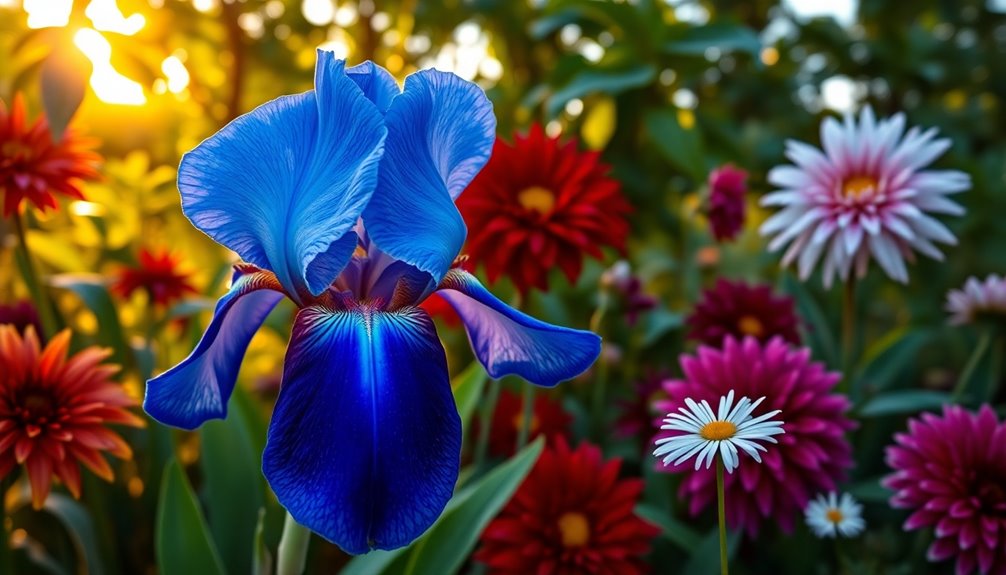
Colors can really change how we feel and think about things!
For example, red makes you think of love or even danger, while blue brings calmness and trust.
Understanding these emotional and cultural meanings of colors can help you see the world in a whole new way!
Emotional Color Associations
Emotional color associations play a significant role in how we interpret and express feelings through art and literature. Different colors can stir up various emotions and symbolize important themes. Here are some common associations:
- Red: This color represents passion and strong emotions like love and anger. It's often used in stories to create intense feelings.
- Blue: Blue symbolizes calmness and tranquility. It evokes a sense of peace, making it a favorite in poetry and visual art.
- Green: Green represents growth and renewal. It reminds us of nature and hope, often appearing in literature to symbolize new beginnings.
Colors can also be linked to joy and happiness. For instance, yellow is associated with warmth and positivity, bringing a sense of joy.
On the other hand, black often symbolizes loss and mourning, while white represents purity and innocence.
Understanding these emotional color associations can enhance your appreciation of art and literature. When you see these colors, think about the feelings they evoke and the stories they tell.
Colors are more than just visuals; they're powerful symbols of our emotions!
Cultural Color Interpretations
Art and literature not only convey emotions through colors but also carry cultural meanings that vary around the world.
For example, in Western cultures, white symbolizes purity and innocence—think of weddings! However, in some Eastern cultures, white represents mourning, worn at funerals. Isn't that interesting?
Red is another powerful color. It often stands for love and passion, especially on Valentine's Day in the U.S. But be careful! Red can also signal danger, like in stop signs.
Then there's green, which is linked to nature and renewal, symbolizing hope and growth. Yet, in some cases, it can mean jealousy, like being "green with envy."
Blue gives off feelings of calmness and tranquility. It's stable and reliable, but it can also hint at sadness, as in feeling blue.
Finally, yellow is bright and cheerful, often representing happiness. In some Asian cultures, yellow stands for courage and nobility.
These cultural color interpretations show how colors can mean different things in different places.
Animal Symbolism
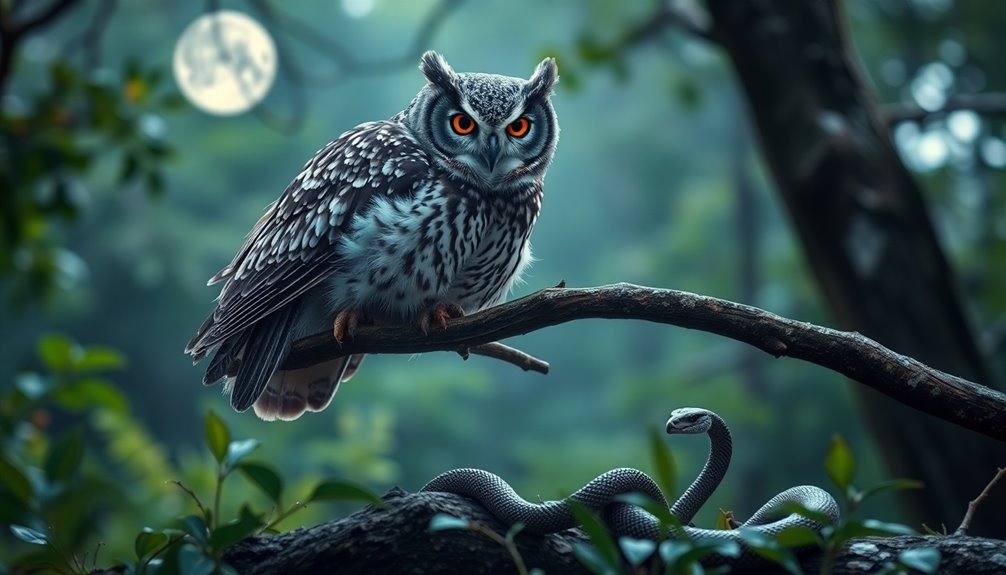
When we think about animal symbolism, we often realize how deeply ingrained these meanings are in our cultures and stories. Animals can represent big ideas and feelings.
Here are three examples of how different animals symbolize important concepts:
- Doves are a universal emblem of peace and tranquility. They remind us of harmony in our communities.
- Lions are often seen as strong and courageous. Characters like Aslan from *The Lion, the Witch and the Wardrobe* show us how they can represent nobility and sacrifice.
- Owls are a symbol of wisdom. In many myths and stories, they guide us toward knowledge and truth.
But not all animal symbolism is warm and fuzzy! For instance, snakes often represent temptation and danger, especially in the tale of Adam and Eve.
Meanwhile, butterflies symbolize transformation and change, reflecting personal growth and the journey of self-discovery.
These animal meanings can help us understand deeper cultural meanings and lessons.
Everyday Object Symbolism

Everyday objects often carry significant symbolism that can enrich our understanding of the world around us. These items represent something deeper and allow us to explore complex ideas. For instance, a wedding ring symbolizes eternal love and commitment, thanks to its perfect circular shape—no beginning and no end.
Similarly, keys often represent access and freedom, opening doors to new experiences and opportunities.
You might see a crown in stories and think of power and authority. It's a powerful symbol commonly used in literature to depict leadership and governance. On the other hand, chains can symbolize bondage or imprisonment, showing how they restrict one's freedom.
Then there's the mirror, a fascinating everyday object that symbolizes self-reflection and truth. It invites you to look inward and understand your identity.
These everyday object symbols help explain an idea or concept, making it easier to relate to feelings and thoughts. Writers love using these symbols because they add depth and meaning to their stories.
Symbolism in Historical Contexts

Symbolism plays an essential role in understanding historical events and cultural shifts. When you look at symbols, you see how two dissimilar things can represent bigger ideas.
Here are a few examples of symbolism that really stand out:
- The Berlin Wall: This wall symbolized the division between East and West Germany, representing the struggle for freedom during the Cold War. Its fall in 1989 was like a light at the end of a long tunnel!
- The Statue of Liberty: A gift from France, this statue symbolizes hope and the ideas of liberty for many immigrants arriving in America. It represents a refuge and new beginnings.
- The American flag: Adopted in 1960, this flag symbolizes national pride and unity. It represents the values of freedom and democracy that many people hold dear.
These examples of symbolism help you understand the emotions and ideas behind historical events.
They show how symbols can connect us to our past and inspire us for the future. When you recognize these symbols, you gain a deeper appreciation for the stories they tell!
Frequently Asked Questions
What Are 5 Examples of Symbolism in Sentences?
You'll discover some great examples of symbolism in literature!
For instance, the green light in *The Great Gatsby* shows Gatsby's hopes.
The conch shell in *Lord of the Flies* stands for order among the boys.
In *To Kill a Mockingbird*, the mockingbird represents innocence.
The scarlet letter "A" in Hawthorne's story symbolizes shame.
Finally, in *The Alchemist*, Santiago's journey is all about chasing your dreams.
Isn't that exciting?
What Is Symbolism 3 Examples?
Symbolism's like a treasure hunt in stories, where objects and colors reveal deeper meanings.
For example, the green light in *The Great Gatsby* shines with Gatsby's dreams.
Then, there's the conch shell in *Lord of the Flies*, which holds the power of order and rules.
Finally, the mockingbird in *To Kill a Mockingbird* sings of innocence, reminding us to protect those who mean no harm.
Symbolism makes reading so much more exciting!
What Are 2 Symbolism Examples?
When you think about symbols in stories, you can find some really cool examples!
For instance, in *The Great Gatsby*, the green light shows Gatsby's hopes and dreams, always just out of reach.
Another great example is the conch shell in *Lord of the Flies*. It represents order and civilization, reminding everyone of the rules.
These symbols add depth to the stories, making them even more exciting to read and explore!
What Is an Example of Symbolism Everyday?
Did you know that over 70% of people recognize a red traffic light means stop? It's a perfect example of symbolism in our everyday lives!
When you see that red light, it's not just a color; it represents safety and caution, reminding you to pause.
Similarly, a wedding ring symbolizes love and commitment.
These symbols help us understand important messages without words, making our daily experiences richer and more meaningful.
Isn't that exciting?
Conclusion
Symbolism is like a treasure hunt in stories, where objects, colors, and animals hold secrets waiting to be discovered. Just as a red rose can mean love, a dark cloud might hint at trouble. Whether you're reading a book or walking through your neighborhood, keep your eyes peeled! You'll find symbols everywhere, adding depth and meaning to what you see. So, immerse yourself in the world of symbolism, and let your imagination soar as you explore these hidden gems!


